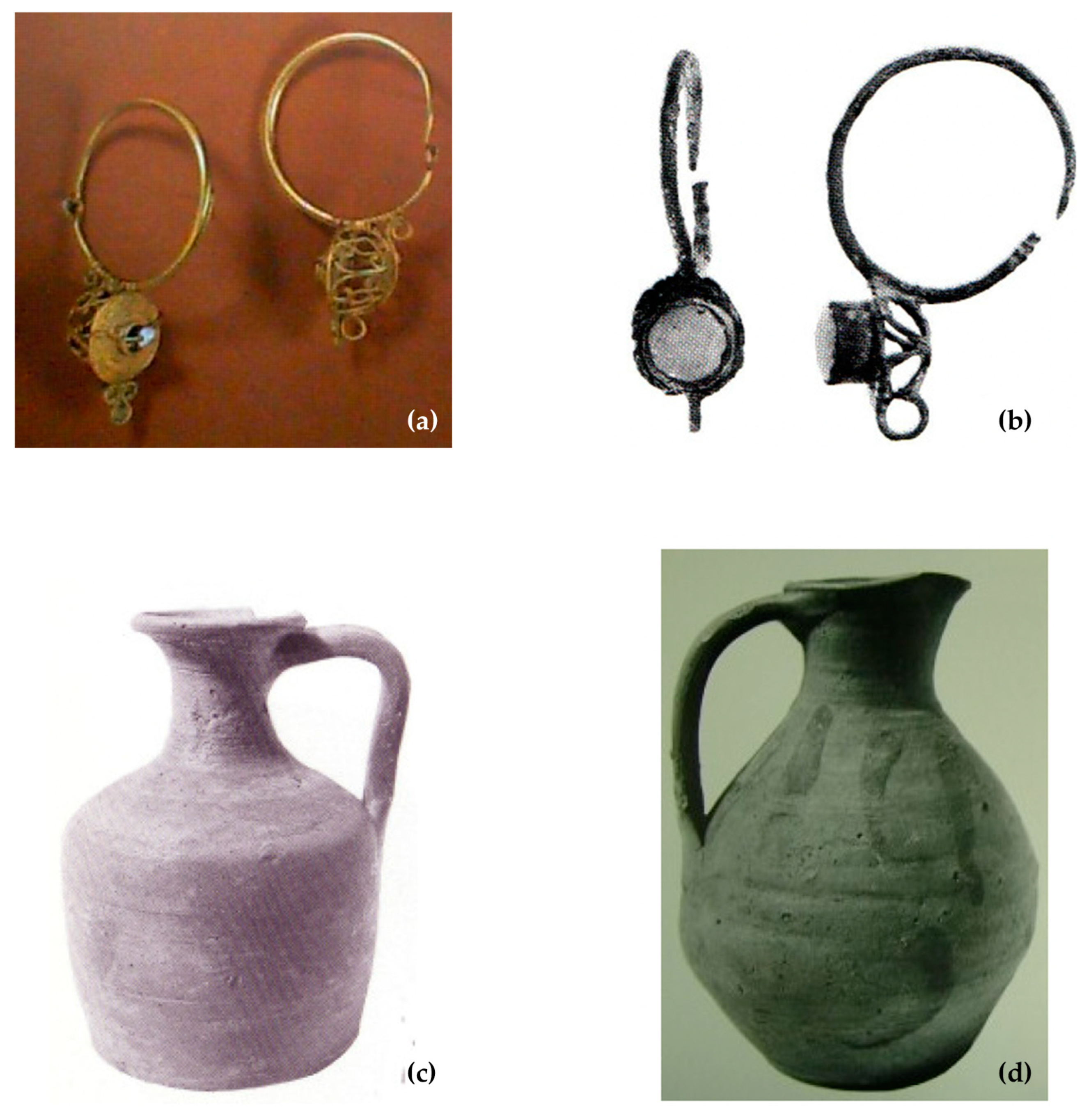Continuity, Resilience, and Change in Rural Settlement Patterns from the Roman to Islamic Period in the Sicani Mountains (Central-Western Sicily)
Abstract
1. Introduction
2. Study Area

3. Historical Context
4. Materials and Methods
4.1. Archaeological Survey
4.2. GIS-Based Spatial Analysis
5. Results
5.1. Topographical Continuity of Roman Sites during the Islamic Period
5.1.1. Contrada Zuccarone (CRL29)
5.1.2. Case Scalilli–Gole del Drago (CRL23)
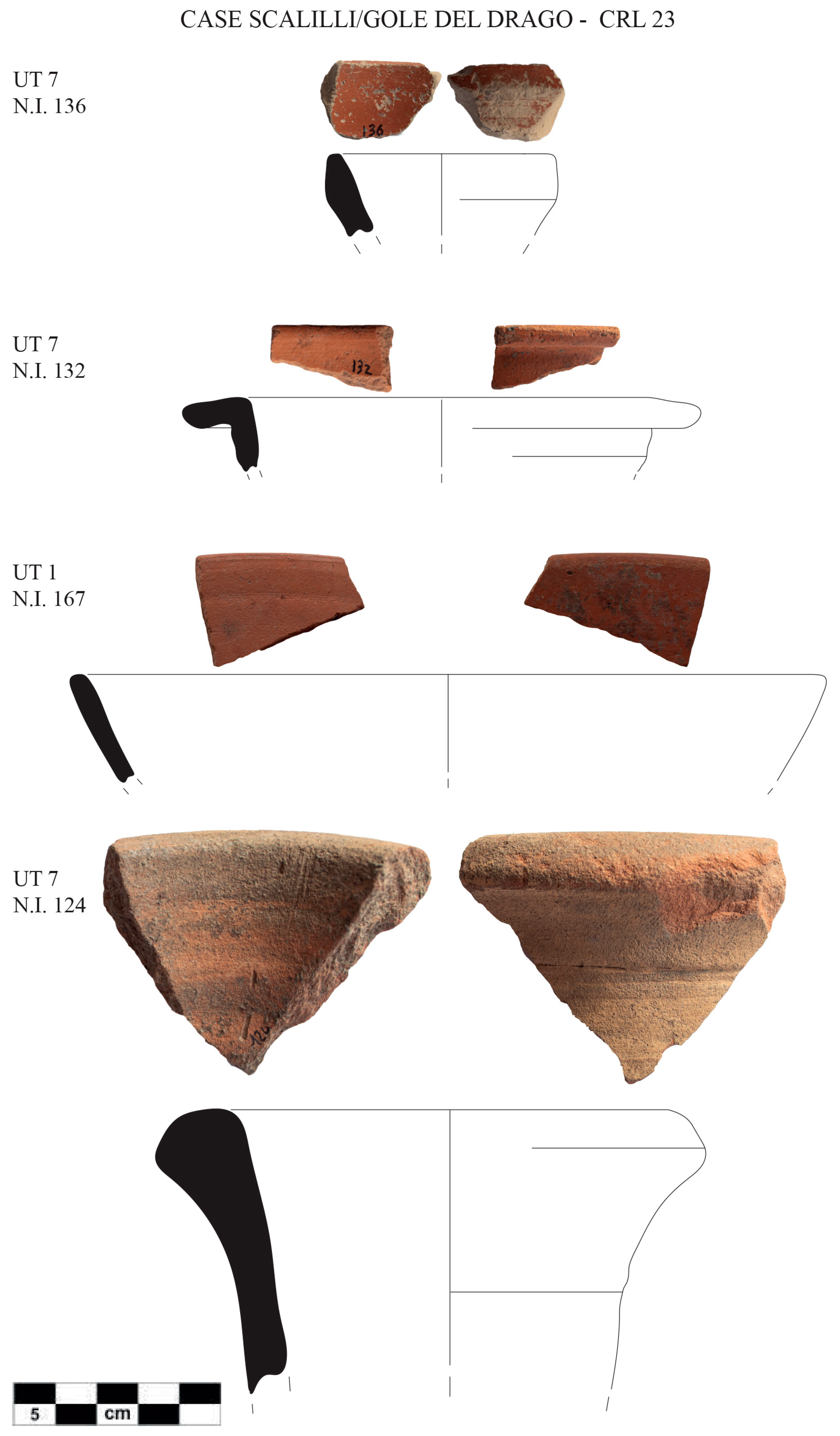
5.2. New Settlement Patterns during the Byzantine Period
Small Byzantine Sites: Costa Rubina (CRL40), Contrada Casale (CRL44), and Case Bingo (CRL47)
5.3. Back to the Hilltop: Early Medieval Reoccupation of Pre-Roman Site
Contrada Castro (CRL53) and Cozzo Spolentino (CRL11)
5.4. New Islamic Sites
5.4.1. Casale di Sotto (CRL3), Casale di Sopra (CRL4)
5.4.2. Masseria Magione (CRL7), Case Grandi di Giammaria (CRL43), and Contrada Carrubba (CRL49)
5.5. Landscape Position Analysis
6. Discussion and Conclusions
Supplementary Materials
Author Contributions
Funding
Data Availability Statement
Acknowledgments
Conflicts of Interest
References
- Amari, M. Storia Dei Musulmani Di Sicilia; Romeo Prampolini: Catania, Italy, 1933. [Google Scholar]
- Granara, W. Narrating Muslim Sicily: War and Peace in the Medieval Mediterranean World; The Early and Medieval Islamic World; I.B. Tauris: London, UK, 2019; ISBN 978-1-78831-306-3. [Google Scholar]
- Molinari, A. ‘Islamization’ and the Rural World: Sicily and al-Andalus. What Kind of Archaeology? In New Directions in Early Medieval European Archaeology: Spain and Italy Compared; Haut Moyen Âge; Gelichi, S., Hodges, R., Eds.; Brepols Publishers: Turnhout, Belgium, 2015; Volume 24, pp. 187–220. ISBN 978-2-503-56520-0. [Google Scholar]
- Giunta, F. A Proposito Di Archeologia Medievale in Sicilia. Sicil. Archeol. 1983, 51, 11–12. [Google Scholar]
- Bresc, H. Carmelo Trasselli Pioniere Dell’archeologia Medievale. Mediterranea 2022, 54, 196–206. [Google Scholar]
- Pesez, J.-M. (Ed.) Brucato. Histoire et Archéologie d’un Habitat Médiéval en Sicile; École Française de Rome: Rome, Italy, 1984. [Google Scholar]
- Aymard, M.; Bresc, H. Problemi di storia dell’insediamento nella sicilia medievale e moderna, 1100–1800. Quad. Stor. 1973, 8, 945–976. [Google Scholar]
- Maurici, F. Archéologie Médiévale «en Sicile» et Archéologie Médiévale «sicilienne». Depuis Les Fouilles de Calathamet Jusqu’à Aujourd’hui: Quelques Considerations. In Calathamet: Archéologie et Histoire d’un Château Normand en Sicile; Lesnes, É., Poisson, J.-M., Eds.; École Française de Rome: Rome, Italy; Officina di Studi Medievali: Palermo, Italy, 2013; pp. 405–416. [Google Scholar]
- Gelichi, S. I quarant’anni di Archeologia Medievale e l’archeologia in Italia negli ultimi quarant’anni. In Archeologia Medievale: Cultura Materiale, Insediamenti, Territorio: 2014, Numero Speciale; All’Insegna del Giglio: Sesto Fiorentino, Italy, 2014. [Google Scholar] [CrossRef]
- Wilson, R.J.A. Sicily under the Roman Empire: The Archaeology of a Roman Province, 36 BC–AD 535; Archaeologists’ Guides to the Roman Empire; Aris and Phillips: Warminster, UK, 1990; ISBN 978-0-85668-160-8. [Google Scholar]
- Maurici, F. Castelli Medievali in Sicilia. Dai Bizantini Ai Normanni; Sellerio: Palermo, Italy, 1992. [Google Scholar]
- Pensabene, P.; Barresi, P. Piazza Armerina, Villa del Casale: Scavi e Studi nel Decennio 2004–2014; Bibliotheca Archaeologica; “L’Erma” di Bretschneider: Roma, Italy, 2019; ISBN 978-88-913-1870-1. [Google Scholar]
- Bonanno, C. (Ed.) Piazza Armerina: L’area Nord Dell’insediamento Medievale Presso la Villa del Casale: Indagini Archeologiche 2013–2014; Access Archaeology; Archaeopress Publishing Ltd.: Oxford, UK, 2020; ISBN 978-1-78969-461-1. [Google Scholar]
- Castrorao Barba, A. Sicily before the Muslims. The Transformation of the Roman Villas between Late Antiquity and the Early Middle Ages, Fourth to Eighth Centuries CE. J. Transcult. Mediev. Stud. 2016, 3, 145–189. [Google Scholar] [CrossRef]
- Molinari, A. Sicily between the 5th and the 10th Century: Villae, Villages, Towns and beyond. Stability, Expansion or Recession? In The Insular System of the Early Byzantine Mediterranean; BAR International Series; Michaelides, D., Pergola, P., Zanini, E., Eds.; BAR: Oxford, UK, 2013; pp. 97–114. [Google Scholar]
- Cacciaguerra, G.; Castrorao Barba, A. The Sicilian Countryside during the Byzantine Period. Archaeological Perspectives on Settlement Patterns. In Perspectives on Byzantine Archaeology; Castrorao Barba, A., Castiglia, G., Eds.; Brepols Publishers: Turnhout, Belgium, 2022; pp. 141–163. ISBN 978-2-503-59684-6. [Google Scholar]
- Arcifa, L. Byzantine Sicily. In A Companion to Byzantine Italy; Brill’s Companions to the Byzantine World; Cosentino, S., Ed.; Brill: Leiden, The Netherlands, 2021; pp. 472–495. ISBN 978-90-04-30770-4. [Google Scholar]
- Vanoli, A. La Sicilia Musulmana; Universale Paperbacks Il Mulino; Il Mulino: Bologna, Italy, 2012; ISBN 978-88-15-23779-8. [Google Scholar]
- Molinari, A. Fortified and Unfortified Settlements in Byzantine and Islamic Sicily: In Fortified Settlements in Early Medieval Europe; Defended Communities of the 8th–10th Centuries; Christie, N., Herold, H., Eds.; Oxbow Books: Oxford, UK, 2016; pp. 320–332. ISBN 978-1-78570-235-8. [Google Scholar]
- Cacciaguerra, G.; Castrorao Barba, A. Dopo i paesaggi delle ville: Nuove dinamiche insediative e siti d’altura nel mondo rurale della Sicilia tardoantica, bizantina ed islamica (V–X/XI Sec.). In Perchement et Réalités Fortifiées en Méditerranée et en Europe, Vème-Xème Siècles; Fortified Hilltop Settlements in the Mediterranean and in Europe (5th–10th Centuries); Pergola, P., Castiglia, G., Hanna, E.E.K., Martinetto, I., Segura, J.-A., Eds.; Archaeopress: Oxford, UK, 2023; pp. 310–323. ISBN 978-1-80327-241-2. [Google Scholar]
- Ardizzone, F.; Pezzini, E.; Sacco, V. Chapter 18 Aghlabid Palermo: Written Sources and Archaeological Evidence1; Brill: Leiden, The Netherlands, 2018; pp. 362–381. ISBN 978-90-04-35604-7. [Google Scholar]
- Sacco, V. The palermitan ceramic production from the ninth to the eleventh century. Libyan Stud. 2020, 51, 74–86. [Google Scholar] [CrossRef]
- Castrorao Barba, A.; Mandalà, G. (Eds.) Suburbia and Rural Landscapes in Medieval Sicily; Limina/Limites: Archaeologies, Histories, Islands and Borders in the Mediterranean (365–1556), 14; Archaeopress Archaeology: Oxford, UK, 2023; ISBN 978-1-80327-545-1. [Google Scholar]
- Bagnera, A.; Nef, A. (Eds.) Les Bains de Cefalà (Xe–XIXe Siècle): Pratiques Thermales D’origine Islamique dans la Sicile Médiévale = I Bagni di Cefalà (Secoli X–XIX): Pratiche Termali D’origine Islamica nella Sicilia Medievale; Collection de l’École Française de Rome, 538; École Française de Rome: Rome, Italy, 2018; ISBN 978-2-7283-1250-4. [Google Scholar]
- Mandalà, G.; de los Utrero Agudo, M.Á. The King’s Hospital in Norman Palermo: San Giovanni dei Lebbrosi in context. In Suburbia and Rural Landscapes in Medieval Sicily; Limina/Limites: Archaeologies, Histories, Islands and Borders in the Mediterranean (365–1556); Castrorao Barba, A., Mandalà, G., Eds.; Archaeopress Archaeology: Oxford, UK, 2023; pp. 12–29. ISBN 1803275464. [Google Scholar]
- Moździoch, S.; Szubert, B.; Moździoch, E. The process of the creation and decline of the local religious and economic centres of Medieval Sicily: A case study of the Santa Maria di Campogrosso monastery. In Suburbia and Rural Landscapes in Medieval Sicily; Limina/Limites: Archaeologies, Histories, Islands and Borders in the Mediterranean (365–1556); Castrorao Barba, A., Mandalà, G., Eds.; Archaeopress Archaeology: Oxford, UK, 2023; pp. 30–43. [Google Scholar]
- Castrorao Barba, A.; Miccichè, R.; Pisciotta, F.; Speciale, C.; Aleo Nero, C.; Marino, P.; Bazan, G. The settlement of Contrada Castro (Corleone, Palermo) between the Byzantine and Islamic periods (7th–11th c. ad). In Suburbia and Rural Landscapes in Medieval Sicily; Castrorao Barba, A., Mandalà, G., Eds.; Limina/Limites: Archaeologies, Histories, Islands and Borders in the Mediterranean (365–1556); Archaeopress Archaeology: Oxford, UK, 2023; pp. 77–93. ISBN 1803275464. [Google Scholar]
- Castrorao Barba, A.; Miccichè, R.; Pisciotta, F.; Speciale, C.; Nero, C.; Marino, P.; Bazan, G. The rural settlement of Contrada Castro (Sicily) between Antiquity and the Early Middle Ages. In Archaeology of the Mediterranean during Late Antiquity and the Middle Age; Castrorao Barba, A., Tanasi, D., Miccichè, R., Eds.; University Press of Florida: Gainesville, FL, USA, 2023; pp. 240–265. ISBN 0-8130-7045-7. [Google Scholar]
- Castrorao Barba, A.; Miccichè, R.; Pisciotta, F.; Marino, P.; Bazan, G. Archeologia nel Territorio dei Monti Sicani (Harvesting Memories Project). L’insediamento di Lunga Durata di Contrada Castro (Corleone, Palermo). Prima Campagna Di Scavo 2017. FOLD&R 2018, 416, 1–21. [Google Scholar]
- Castrorao Barba, A.; Miccichè, R.; Pisciotta, F.; Speciale, C.; Aleo Nero, C.; Vassallo, S.; Marino, P.; Bazan, G. Nuovi Dati Sull’occupazione Altomedievale Dell’insediamento di Contrada Castro (Corleone, Palermo) Nell’area dei Monti Sicani. FOLD&R 2020, 468, 1–15. [Google Scholar]
- Rizzo, M.S. L’ Insediamento Medievale nella Valle dei Platani; Studi e Materiali/Dipartimento di Beni Culturali, Sezione Archeologica; Università di Palermo, L’Erma di Bretschneider: Roma, Italy, 2004; ISBN 978-88-8265-316-3. [Google Scholar]
- Molinari, A. La Sicilia islamica: Riflessioni sul passato e sul futuro della ricerca in campo archeologico. In MEFRM: Mélanges De L’école Française De Rome: Moyen-Âge; L’école Française De Rome: Rome, Italy, 2004. [Google Scholar] [CrossRef]
- Maurici, F. L’insediamento Medievale nel Territorio della Provincia di Palermo: Inventario Preliminare degli Abitati Attestati dalle Fonti D’archivio (Secoli 11–16); Regione Siciliana: Palermo, Italy, 1998. [Google Scholar]
- Nef, A.; Ardizzone, F. (Eds.) Les Dynamiques de l’Islamisation en Méditerranée Centrale et en Sicile: Nouvelles Propositions et Découvertes Récentes = Le Dinamiche dell’Islamizzazione del Mediterraneo Centrale in Sizilia: Nuove Proposte e Scoperte Recenti; Collection de l’École Française de Rome, Edipuglia: Bari, Italy, 2014; ISBN 978-88-7228-735-4. [Google Scholar]
- Arcifa, L. La Sicilia e il Mediterraneo dal Tardoantico al Medioevo: Prospettive di Ricerca tra Archeologia e Storia: Atti del Convegno Internazionale di Studi Dedicato a Fabiola Ardizzone lo Bue; Palermo University Press: Palermo, Italy, 2022; ISBN 978-88-550-9403-0. [Google Scholar]
- Spatafora, F. Ricerche e prospezioni nel territorio di Corleone: Insediamenti preistorici e centri indigeni. In Atti delle Seconde Giornate di Studi sull’Area Elima (Gibellina 1994); Scuola Normale Superiore di Pisa, Comune di Gibellina: Pisa, Italy, 1997; pp. 1273–1286. [Google Scholar]
- Scuderi, A.; Tusa, S.; Vintaloro, A. La Preistoria e Protostoria del Territorio di Corleone nel Quadro della Sicilia Occidentale; Città di Corleone/Archeoclub di Corleone: Corleone, Italy, 1996. [Google Scholar]
- Vintaloro, A.; Orlando, M. Corleone Archeologica III; Città di Corleone/Archeoclub di Corleone: Corleone, Italy, 2019. [Google Scholar]
- Vintaloro, A.; Scuderi, A. Corleone Archeologica I: Studio Storico-Archeologico sul Territorio Corleonese; Città di Corleone/Archeoclub di Corleone: Corleone, Italy, 1995. [Google Scholar]
- Corretti, A.; Facella, A.; Gulletta, M.I.; Michelini, C.; Vaggioli, M.A. (Eds.) Entella II: Carta Archeologica del Comune di Contessa Entellina dalla Preistoria al Medioevo; Scuola Normale Superiore di Pisa: Pisa, Italy, 2021; ISBN 978-88-7642-700-8. [Google Scholar]
- Johns, J. The Monreale Survey: Indigenes and invaders in Medieval West Sicily. In Papers in Italian Archaeology IV. The Cambridge Conference, Part IV: Classical and Medieval Archaeology; Malone, C., Stoddart, S., Eds.; BAR International Series; BAR: Oxford, UK, 1985; pp. 215–224. [Google Scholar]
- Spatafora, F. Tracce di culto nell’entroterra sicano: Il santuario extraurbano di Cozzo Spolentino (Palermo). In L’Occident Grec de Marseille à Mégara Hyblaea; Bouffier, S., Hermary, A., Eds.; Publications du Centre Camille Jullian: Aix-en-Provence, France, 2013; pp. 277–294. ISBN 978-2-87772-553-8. [Google Scholar]
- D’Angelo, F.; Spatafora, F. La Vecchia di Corleone. In Federico e la Sicilia, dalla Terra alla Corona. Archeologia e Architettura; Di Stefano, C.A., Cadei, A., Eds.; Ediprint: Siracusa, Italy, 1995; Volume 1, pp. 173–175. [Google Scholar]
- Spatafora, F. La Vecchia di Corleone. Archeol. Viva 1996, 59, 34–40. [Google Scholar]
- Castrorao Barba, A.; Speciale, C.; Miccichè, R.; Pisciotta, F.; Aleo Nero, C.; Marino, P.; Bazan, G. The Harvesting Memories Project: Historical Ecology and Landscape Changes of the Sicani Mountains in Sicily. Ecocycles 2022, 8, 51–60. [Google Scholar] [CrossRef]
- Bazan, G.; Castrorao Barba, A.; Rotolo, A.; Marino, P. Vegetation series as a marker of interactions between rural settlements and landscape: New insights from the archaeological record in Western Sicily. Landsc. Res. 2020, 45, 484–502. [Google Scholar] [CrossRef]
- Liguori, V. Geologia, Geomorfologia, Idrologia. In Linee Guida del Piano Territoriale Paesistico Regionale; Regione Siciliana: Palermo, Italy, 1996. [Google Scholar]
- Sestini, A. Il Paesaggio; Conosci l’Italia; Touring Club Italiano: Milano, Italy, 1963; Volume 7. [Google Scholar]
- Duro, A.; Piccione, V.; Scalia, C.; Zampino, S. Precipitazioni e temperature medie mensili in Sicilia relative al sessantennio 1926–1985. In Proceedings of the Atti 5° Workshop Progetto Strategico Clima, Ambiente e Territorio nel Mezzogiorno CNR; ISHS: Leuven, Belgium, 1996. [Google Scholar]
- Rivas-Martínez, S.; Rivas-Saenz, S.; Penas, A. Worldwide Bioclimatic Classification System. Glob. Geobot. 2002, 1, 1–638. [Google Scholar] [CrossRef]
- Gianguzzi, L.; Bazan, G. The Olea Europaea L. Var. Sylvestris (Mill.) Lehr. Forests in the Mediterranean Area. Plant Sociol. 2019, 56, 3–34. [Google Scholar] [CrossRef]
- Bazan, G.; Marino, P.; Guarino, R.; Domina, G.; Schicchi, R. Bioclimatology and vegetation series in Sicily: A geostatistical approach. Ann. Bot. Fenn. 2015, 52, 1–18. [Google Scholar] [CrossRef]
- Schicchi, R.; Speciale, C.; Amato, F.; Bazan, G.; Di Noto, G.; Marino, P.; Ricciardo, P.; Geraci, A. The monumental olive trees as biocultural heritage of Mediterranean landscapes: The case study of Sicily. Sustainability 2021, 13, 6767. [Google Scholar] [CrossRef]
- Marino, P.; Guarino, R.; Bazan, G. The Sicilian taxa of genista sect. voglera and their phytosociological framework. Flora Mediterr. 2012, 22, 169–190. [Google Scholar] [CrossRef]
- Marino, P.; Castiglia, G.; Bazan, G.; Domina, G.; Guarino, R. ertiary relict laurophyll vegetation in the madonie mountains (Sicily). Acta Bot. Gall. 2014, 161, 47–61. [Google Scholar] [CrossRef][Green Version]
- Bazan, G.; Castrorao Barba, A.; Rotolo, A.; Marino, P. Geobotanical approach to detect land-use change of a mediterranean landscape: A case study in Central-Western Sicily. GeoJournal 2019, 84, 795–811. [Google Scholar] [CrossRef]
- Ministero dell’Ambiente Geoportale Nazionale. Distributed under the Terms and Conditions of the Creative Commons Attribution (CC BY-NC) License. Available online: https://gn.mase.gov.it/portale/servizio-di-consultazione-wms (accessed on 2 February 2022).
- Bejor, G. Corleone. In Bibliografia Topografica della Colonizzazione Greca in Italia e nelle Isole Tirreniche; Scuola normale superiore: Pisa, Italy; École Française de Rome: Rome, Italy, 1987; Volume 5, pp. 418–420. [Google Scholar]
- Colletto, G. Storia della Citta di Corleone; Helix Media: Palermo, Italy, 1992. [Google Scholar]
- Gulletta, M.I. Schera. In Bibliografia Topografica della Colonizzazione Greca in Italia e nelle Isole Tirreniche; Scuola normale superiore: Pisa, Italy; École Française de Rome: Rome, Italy, 2010; Volume 18, pp. 448–457. [Google Scholar]
- Clüver, P. Philippi CluverI Sicilia Antiqua; Cum Minoribus Insulis, Ei Adjacentibus. Item, Sardinia et Corsica. Opus Post Omnium Curas Elaboratissimum; Tabulis Geographicis, Aere Expressis, Illustratum; Ex Officina Elseviriana: Lugduni Batavorum, The Netherlands, 1619. [Google Scholar]
- Houel, J. Voyages Pittoresques des Îles de Sicile, de Lipari et de Malte Où l’on Traite des Antiquités Qui s’y Trouvent Encore; Des Principaux Phénomènes que la Nature y Offre; Du Costume des Habitants, & de Quelques Usages; Imprimerie de Monsieur: Paris, France, 1782. [Google Scholar]
- Trasselli, C. Schera-Corleone o Monte dei Cavalli. Sicil. Archeol. 1969, 7, 19–28. [Google Scholar]
- Badami, A.; Carta, M. Storia Urbanistica della Città di Corleone; Dipartimento Città e Territorio: Palermo, Italy, 1993. [Google Scholar]
- Prag, J. Il miliario di Aurelius Cotta (ILLRP n.1277): Una lapide in contesto. In Guerra e Pace in Sicilia e nel Mediterraneo antico (VIII-III sec.a.C.). Arte, Prassi e Teoria della Pace e della Guerra (Atti V Giornate Internazionali (Erice 2003); Ampolo, C., Ed.; Edizioni Della Normale: Pisa, Italy, 2006; Volume 2, pp. 733–744. [Google Scholar]
- Di Vita, A. Una recente nota e la datazione del miliario siciliano del console C. Aurelio Cotta. Latomus 1963, 22, 478–488. [Google Scholar]
- Amari, M. Biblioteca Arabo-Sicula; E. Loescher: Torino, Italy, 1880; Volume I. [Google Scholar]
- Amari, M. Biblioteca Arabo-Sicula; E. Loescher: Torino, Italy, 1881; Volume II. [Google Scholar]
- Al-Muqaddasī, M.I.-A.; Collins, B.A.; al-Muqaddasī, M.I.-A. The Best Divisions for Knowledge of the Regions: A Translation of Ahsan al-Taqasim Fi Maʿrifat al-Aqalim; Great Books of Islamic Civilization, 1st ed.; Garnet: Reading, UK, 1994; ISBN 978-1-873938-14-0. [Google Scholar]
- Bresc, H.; Nef, A. (Eds.) Idrīsī. La Première Géographie de l’Occident; GF Flammarion: Paris, France, 1999; ISBN 978-2-08-071069-7. [Google Scholar]
- Johns, J. Sulla condizione dei musulmani di Corleone sotto il dominio normanno nel XII secolo. In Bizantino-Sicula IV. Atti del I Congresso Internazionale di Archeologia della Sicilia Bizantina, Palermo, (Corleone, 28 Luglio–2 Agosto 1998); Bonacasa Carra, R.M., Ed.; Istituto Siciliano di Studi Bizantini e Neoellenici: Palermo, Italy, 2002; pp. 275–294. [Google Scholar]
- Bover Fonts, I. L’iqlîm di Corleone: Studio del territorio e della sua popolazione durante l’epoca musulmana. Ann. Dell’istituto Orient. Di Napoli 1996, 56, 257–264. [Google Scholar]
- Regione Siciliana S.I.T.R—Sistema Informativo Territoriale Regionale. Available online: https://www.sitr.regione.sicilia.it/ (accessed on 2 February 2024).
- Weiss, A. Topographic Position and Landforms Analysis. In Proceedings of the Poster Presentation, ESRI User Conference, San Diego, CA, USA, 9–13 July 2001; Volume 200. [Google Scholar]
- R Core Team. R Foundation for Statistical Computing R: A Language and Environment for Statistical Computing; R Core Team: Vienna, Austria, 2015. [Google Scholar]
- Jolliffe, I.T. Principal Component Analysis; Springer Series in Statistics; Springer: New York, NY, USA, 2002; ISBN 978-0-387-95442-4. [Google Scholar]
- Klijn, F.; De Haes, H.A.U. A hierarchical approach to ecosystems and its implications for ecological land classification. Landsc. Ecol. 1994, 9, 89–104. [Google Scholar] [CrossRef]
- Uggeri, G. La viabilità della Sicilia in età romana; Journal of Ancient Topography—Rivista di Topografia Antica Supplemento II; Congedo Editore: Galatina, Italy, 2004; ISBN 88-8086-559-5. [Google Scholar]
- Cibecchini, F.; Capelli, C. Nuovi dati archeologici e archeometrici sulle anfore greco italiche: I relitti di III secolo del Mediterraneo occidentale e la possibilità di una nuova classiicazione. In Itinéraires des Vins Romains en Gaule IIIe–Ier Siècles Avant J.-C. Confrontation de Faciès, Actes du Collo-que Européen Organisé par l’UMR 5140 du CNRS Lattes, 30 Janvier–2 Février 2007; Olmer, F., Ed.; Publication de l’UMR 5140 du CNRS: Lattes, Italy, 2013; pp. 423–451. [Google Scholar]
- Hayes, J.W. Late Roman Pottery; British School at Rome: London, UK, 1972; ISBN 978-0-904152-00-5. [Google Scholar]
- Bonifay, M. Etudes sur la Céramique Romaine Tardive d’Afrique; BAR International Series; Archaeopress: Oxford, UK, 2004; ISBN 978-1-84171-651-0. [Google Scholar]
- Fiertler, G. La Pantellerian Ware dal quartiere ellenistico-romano di Agrigento: Aspetti della problematica e proposta per una tipologia. In Archeologia del Mediterraneo: Studi in Onore di Ernesto de Miro. Bibliotheca Archaeologica 35; “L’Erma” di Bretschneider: Roma, Italy, 2003; ISBN 978-88-913-0221-2. [Google Scholar]
- Baldassari, R. La Produzione della Ceramica a Pantelleria e la sua Circolazione in età Tardo Antica. Ph.D. Thesis, Università degli Studi di Sassari, Sassari, Italy, 2014. [Google Scholar]
- Sacco, V. Produzione e circolazione delle anfore palermitane tra la fine del IX e il XII secolo. Archeol. Mediev. 2018, 45, 175–192. [Google Scholar] [CrossRef]
- Sacco, V. Le ceramiche invetriate di età islamica a Palermo: Nuovi dati dalle sequenze del quartiere della Kalsa. Archeol. Mediev. 2017, 44, 337–366. [Google Scholar] [CrossRef]
- Ardizzone, F.; Pezzini, E.; Sacco, V. Lo scavo della chiesa di Santa Maria degli Angeli alla Gancia: Indicatori archeologici della prima età islamica a Palermo. In Les Dynamiques de l’Islamisation en Méditerranée Centrale et en Sicile: Nouvelles Propositions et Découvertes Récentes = Le Dinamiche dell’Islamizzazione del Mediterraneo Centrale in Sizilia: Nuove Proposte e Scoperte Recenti; Nef, A., Ardizzone, F., Eds.; École Française de Rome: Roma, Italy, 2014; pp. 197–223. ISBN 978-88-7228-735-4. [Google Scholar]
- Ardizzone, F.; Agrò, F. Una discarica di età islamica fuori le mura della città di Palermo. Archeol. Postmedievale Soc. Ambiente Produzione 2012, 2012, 16. [Google Scholar] [CrossRef]
- Molinari, A.; Meo, A. (Eds.) Mazara/Māzar: Nel Ventre della Città Medievale (Secoli VII–XV): Edizione Critica degli Scavi (1997) in via Tenente Gaspare Romano; Biblioteca di Archeologia Medievale 32; All’insegna del Giglio: Firenca, Italy, 2021; ISBN 978-88-928-5046-0. [Google Scholar]
- Aleo Nero, C. Lucerne medievali a Palermo e nel territorio, nuove scoperte e vecchi dati a confronto. In Proceedings of the Atti del XLIX Convegno Internazionale della Ceramica (Savona 2016), Firenze, Italy, 27–28 May 2017; pp. 319–336. [Google Scholar]
- Rizzo, M.S.; Fiorilla, S.; Guzzetta, G. Nuove osservazioni sulle produzioni delle fornaci di S. Lucia ad Agrigento. Cronache Di Archeol. 2021, 40, 435–460. [Google Scholar]
- Agrò, F. A proposito dell’invetriata verde con decorazione solcata di produzione siciliana. Nuovi dati e vecchie linee di ricerca. In Proceedings of the Amalfi e la Sicilia nel Medioevo: Uomini, Commerci, Culture: Atti del Convegno, Amalfi, Italy, 13–14 Dicembre 2019; Centro di Cultura e Storia Amalfitana: Amalfi, Italy, 2022; pp. 303–320. [Google Scholar]
- Olcese, G. Terra sigillata italica a roma e in area romana: Produzione, circolazione e analisi di laboratorio (Con Il Contributo Di M. Picon). Rei Cretariae Rom. Fautorum Acta Roma 2003, 38, 11–26. [Google Scholar]
- Malfitana, D.; Bonifay, M. (Eds.) La Ceramica Africana nella Sicilia Romana; Monografie dell’Istituto per i beni Archeologici e Monumentali; IBAM/CCJ: Catania, Italy, 2016; ISBN 978-88-89375-13-6. [Google Scholar]
- Di Stefano, C.A. Il territorio della provincia di Palermo tra la tarda età romana e l’età bizantina. problemi aperti e nuove acquisizioni. In Proceedings of the Bizantino-Sicula IV. Atti del I Congresso Internazionale di Archeologia della Sicilia Bizantina, Palermo, Italy, 28 July–2 August 1998; Bonacasa Carra, R.M., Ed.; Istituto Siciliano di Studi Bizantini e Neoellenici: Palermo, Italy, 2002; pp. 307–322. [Google Scholar]
- Puglisi, M.; Sardella, A. Ceramica locale in Sicilia Tra VI e VII Secolo d.C. Situazione attuale e prospettive future della ricerca. In Proceedgins of the Ceramica in Italia: VI–VII Secolo, Atti del Convegno in Onore di John, W. Hayes, Roma, Italy, 11–13 Maggio 1995; All’Insegna del Giglio: Rome, Italy, 1998; pp. 777–785. ISBN 88-7814-128-3. [Google Scholar]
- Arcifa, L. Indicatori archeologici per l’alto medioevo nella sicilia orientale. In Piazza Armerina: Villa del Casale e la Sicilia tra Tardoantico e Medioevo; Pensabene, P., Ed.; Studia Archaeologica, L’Erma” di Bretschneider: Roma, Italy, 2010; pp. 105–128. [Google Scholar]
- Dannheimer, H. Byzantinische Grabfunde aus Sizilien Christliches Brauchtum im Frühen Mittelalter; Ausstellungskataloge der Archäologischen Staatssammlung, Prähistorische Staatssammlung: München, Gemany, 1989; ISBN 978-3-927806-03-0. [Google Scholar]
- Metaxas, S. Die Materielle Kultur des byzantinischen Sizilien (6–10. Jahrhundert); Universität Wien: Vienna, Austria, 2009. [Google Scholar]
- Castrorao Barba, A.; Rotolo, A.; Bazan, G.; Marino, P.; Vassallo, S. Long-Term human occupation of a Rural Landscape in Central-Western Sicily (Castro/Giardinello Valley and Mt Barraù): Harvesting Memories Project case study. ArkeoGazte 2017, 7, 175–192. [Google Scholar]
- Bazan, G.; Speciale, C.; Castrorao Barba, A.; Cambria, S.; Miccichè, R.; Marino, P. Historical Suitability and Sustainability of Sicani Mountains Landscape (Western Sicily): An Integrated Approach of Phytosociology and Archaeobotany. Sustainability 2020, 12, 3201. [Google Scholar] [CrossRef]
- Castrorao Barba, A.; Speciale, C.; Miccichè, R.; Pisciotta, F.; Aleo Nero, C.; Marino, P.; Bazan, G. The Sicilian Countryside in the Early Middle Ages: Human–Environment Interactions at Contrada Castro. Environ. Archaeol. 2023, 28, 240–255. [Google Scholar] [CrossRef]
- Montana, G.; Gasparo Morticelli, M.; Bazan, G.; Pisciotta, F.; Aleo Nero, C.; Marino, P.; Castrorao Barba, A. Sources of Geomaterials in the Sicani Mountains during the Early Middle Ages: A Case Study of Contrada Castro, Central Western Sicily. Geoarchaeology 2022, 37, 617–636. [Google Scholar] [CrossRef]
- Maurici, F.; Vassallo, S. Due siti medievali nel territorio Santa Maria la Nuova di Monreale. Sicil. Archeol. 1987, 20, 13–28. [Google Scholar]
- Sacco, V. L’islamizzazione a Palermo attraverso due contesti di palazzo Bonagia (scavi di Stefano). In Les Dynamiques de l’Islamisation en Méditerranée Centrale et en Sicile: Nouvelles Propositions et Découvertes Récentes = Le Dinamiche Dell’islamizzazione del Mediterraneo Centrale in Sizilia: Nuove Proposte e Scoperte Recenti; Nef, A., Ardizzone, F., Eds.; École Française de Rome: Rome, Italy, 2014; pp. 225–231. ISBN 978-88-7228-735-4. [Google Scholar]
- Ardizzone Lo Bue, F. Anfore in Sicilia VIII–XII Sec. dC.; Torri del Vento: Palermo, Italy, 2012; ISBN 978-88-97373-29-2. [Google Scholar]
- Ardizzone, F.; D’Angelo, F.; Pezzini, E.; Sacco, V. Ceramiche di età islamica provenienti da Castello della Pietra (Trapani). In Atti del IX Congresso Internazionale sulla Ceramica Medievale nel Mediterraneo: Venezia, Scuola Grande dei Carmini, Auditorium Santa Margherita, 23–27 Novembre 2009; Gelichi, S., Ed.; All’Insegna del Giglio: Firenze, Italy, 2012; pp. 167–172. [Google Scholar]
- D’Angelo, F. Sicilia XII Secolo: Importazioni dal Mediterraneo orientale, importazioni dal Mediterraneo occidentale, produzioni locali. In Proceedings of the Atti del IX Congresso Internazionale sulla Ceramica Medievale nel Mediterraneo, Venezia, Italy, 23–27 November 2009; Gelichi, S., Ed.; All’Insegna del Giglio: Firenze, Italy, 2012; pp. 178–180. ISBN 978-88-7814-540-5. [Google Scholar]
- Spatafora, F.; Canzonieri, E.; Di Leonardo, L. Ceramica da mensa nella Palermo di XI secolo: Dalla fornace al butto. Archeol. Postmedievale 2012, 16, 23–33. [Google Scholar]
- Sacco, V.; Pezzini, E. le produzioni da fuoco a Palermo (IX–XI Secolo). In Proceedings of the XIth Congress AIECM3 on Medieval and Modern Period Mediterranean Ceramics Proceedings, Antalya, Turkey, 19–24 October 2015; Yenişehirlioğlu, F., Ed.; Koc Universitesi VEKAM: Ankara, Turkey, 2018; pp. 347–356. [Google Scholar]
- Edmonds, W.J.; Thomas, P.J.; Simpson, T.W.; Baker, J.C. Land Judging and Soil Evaluation; Virginia Polytechnic Institute and State University Department of Crop and Soil Environmental Sciences: Blacksburg, USA, 1998. [Google Scholar]
- Arcifa, L. Dinamiche insediative e grande proprietà nella Sicilia bizantina. In L’héritage Byzantin en Italie (VIIIe–XIIe Siècle); Martin, J.-M., Peters-Custot, A., Prigent, V., Eds.; Publications de l’École Française de Rome: Rome, Italy, 2017; pp. 237–267. ISBN 978-2-7283-1224-5. [Google Scholar]
- Nef, A.; Prigent, V. Contrôle et exploitation des campagnes en Sicile: Le rôle du grand domaine et son évolution du VIe Siècle au XIe Siècle. In Authority and Control in the Countryside. From Antiquity to Islam in the Mediterranean and Near East (6th–10th Century); Leiden Studies in Islam and Society; Delattre, A., Legendre, M., Sijpesteijn, P., Eds.; Brill: Leiden, Belgium, 2018; pp. 313–366. ISBN 978-90-04-38654-9. [Google Scholar]
- Burgio, A. Il Paesaggio Agrario nella Sicilia Ellenistico-Romana: Alesa e il Suo Territorio; Studi e Materiali; “L’Erma” di Bretschneider: Rome, Italy, 2008; ISBN 978-88-8265-483-2. [Google Scholar]
- Konstantin; Haldon, J.F. The De Thematibus (‘on the Themes’) of Constantine VII Porphyrogenitus: Translated with Introductory Chapters and Notes; Translated Texts for Byzantinists; Liverpool University Press: Liverpool, UK, 2021; ISBN 978-1-80085-998-2. [Google Scholar]
- Molinari, A. Sicily from Late Antiquity to the Early Middle Ages: In Change and Resilience; The Occupation of Mediterranean Islands in Late Antiquity; Ontiveros, M.Á.C., Florit, C.M., Eds.; Oxbow Books: Oxford, UK, 2019; Volume 9, pp. 87–110. ISBN 978-1-78925-180-7. [Google Scholar]
- Civantos, J.M.M.; García, M.T.B.; Corselli, R.; Jiménez, A.P.R.; Maestro, E.C. Arqueología del paisaje en Trapani: Primera campaña de excavación en elgranero colectivo fortificado de Pizzo Monaco (Custonaci-Trapani, Italia). Inf. Trab. Excavaciones Exter. 2016, 14, 131–151. [Google Scholar]
- Lesnes, É.; Poisson, J.M. Calathamet: Archéologie et Histoire d’un Château Normand En Sicile; Collection de l’École Française de Rome; École Française de Rome, Officina di Studi Medievali: Rome, Italy, 2013; ISBN 978-88-6485-068-9. [Google Scholar]
- Di Liberto, R. L’apporto dell’architettura normanna alla conoscenza dell’ars fortificatoria islamica in Sicilia: Il contributo dell’analisi stratigrafica delle murature. Mélanges L’école Française Rome Moyen Âge 2004, 116, 319–350. [Google Scholar] [CrossRef]
- Rotolo, A. The Trodden Path: GIS-Analyses of Settlement and Mobility Patterns in Western Sicily during the Islamic Period. JIA 2016, 3, 109–136. [Google Scholar] [CrossRef]
- Kirk, S. Sicilian Castles and Coastal Towers. Open Archaeol. 2017, 3, 21. [Google Scholar] [CrossRef][Green Version]
- Metcalfe, A. Muslims and Christians in Norman Sicily: Arabic-Speakers and the End of Islam; Culture and civilization in the Middle East; Routledge Curzon: London, UK; New York, NY, USA, 2003; ISBN 978-0-7007-1685-2. [Google Scholar]
- Nef, A. Conquérir et Gouverner la Sicile Islamique aux XIe et XIIe Siècles; Bibliothèque des Écoles Françaises d’Athènes et de Rome; Publications de l’École Française de Rome: Rome, Italy, 2011; ISBN 978-2-7283-0889-7. [Google Scholar]
- Vassallo, S. Pizzo Nicolosi. Bibliogr. Topogr. Della Colon. Greca Ital. E Nelle Isole Tirreniche 1996, 14, 32–34. [Google Scholar]
- Cusa, S. I Diplomi Greci ed Arabi di Sicilia Pubblicati nel Testo Originale, Tradotti ed Illustrati da Salvatore Cusa: I, 1; Stabilimento Lipograf. Lao.: Palermo, Italy, 1868. [Google Scholar]
- Greco, C. Un sito tardoromano sulla via Agrigentum-Panormus: Scavi nella necropoli in Contrada S. Agata (Piana degli Albanesi). Kokalos 1993, 39–40, 1143–1163. [Google Scholar]
- Toomaspoeg, K. Les Teutoniques En Sicile (1197–1492); Collection de l’École Française de Rome; École Française de Rome: Rome, Italy, 2003; ISBN 2-7283-0655-9. [Google Scholar]
- Toomaspoeg, K. Base Économique de l’expansion des bourgs siciliens. Exemple des possessions de l’Ordre Teutonique dans la zone Corleone-Vicari-Castronovo, 1220–1310. In Proceedings of the Actas del XVII Congreso de Historia de la Corona de Aragón,“El món urbà a la Corona d’Aragó del 1137 als decrets de Nova Planta”, Barcelona, Spain, 7–12 September 2000; Claramunt Rodríguez, S., Ed.; Universidad de Barcelona: Barcelona, Spain, 2003; Volume 1, pp. 595–604. [Google Scholar]
- Metcalfe, A. The Muslims of Medieval Italy; The New Edinburgh Islamic Surveys; Edinburgh University Press: Edinburgh, UK, 2009; ISBN 978-0-7486-2007-4. [Google Scholar]
- Chiarelli, L.C. A History of Muslim Sicily, 2nd ed.; Central Mediterranean Studies Series; Midsea Books: Venera, Malta, 2018; ISBN 978-99932-7-645-6. [Google Scholar]
- Bresc, H. Nommer La Ville: L’exemple de La Sicile (Xe-XVIIIe Siècle). In Compositions Urbaines au Moyen Âge. Actes du 137e Congrès National des Sociétés Historiques et Scientifiques (Tours, 2012); Editions du CTHS: Paris, France, 2015; pp. 5–20. [Google Scholar]
- Caracausi, G. Dizionario Onomastico della Sicilia: Repertorio Storico-Etimologico di Nomi di Famiglia e di Luogo; l’Epos: Palermo, Italy, 1993; ISBN 978-88-8302-053-7. [Google Scholar]
- Wehr, H.; Cowan, J.M. A Dictionary of Modern Written Arabic: Arabic–English, 4th ed.; Considerably Enl. and Amended by the Author; Harrassowitz: Wiesbaden, Germany, 1979; ISBN 978-3-447-02002-2. [Google Scholar]
- Mercier, R.P. Geodesy. In The History of Cartography, Vol.II, Book I: Cartography in the Traditional Islamic and South Asian Societies; Harley, J.B., Woodward, D., Eds.; University of Chicago Press: Chicago, IL, USA; pp. 175–188.
- Santagati, L. Viabilità e Topografia della Sicilia Antica. Bd. II: La Sicilia Altomedievale ed Arabo-Normanna; Edizioni Lussografica: Caltanissetta, Italy, 2013. [Google Scholar]
- Bazzana, A.; Cressier, P.; Guichard, P. Les Châteaux Ruraux d’al-Andalus: Histoire et Archéologie des Ḥuṣūn du Sud-Est de l’Espagne; Publications de la Casa de Velázquez. Série Archéologie; Casa de Velázquez: Madrid, Spain, 1988; ISBN 978-84-600-5814-4. [Google Scholar]
- Epalza, M. De funciones ganaderas de los albacares en las fortalezas musulmanas. Sharq Al-Andalus 1984, 1, 47–54. [Google Scholar] [CrossRef]
- Bazzana, A. Les Structures: Fortification et Habitat. In Proceedings of the Castrum I. Habitats Fortifiés et Organisation de L’espace en Méditerranée Médiévale. Table Ronde Tenue à Lyon les 4 et 5 mai 1982; Maison de l’Orient et de la Méditerranée Jean Pouilloux: Lyon, France, 1983. [Google Scholar]
- Wickham, C. The Donkey and the Boat: Reinterpreting the Mediterranean Economy, 950–1180, 1st ed.; Oxford University Press: Oxford, UK, 2023; ISBN 978-0-19-885648-1. [Google Scholar]
- Fierotti, G.; Dazzi, C.; Raimondi, S. Commento alla Carta dei Suoli della Sicilia; Istituto di Agronomia Generale: Palermo, Italy, 1988. [Google Scholar]
- Metcalfe, A. Dynamic Landscapes and Dominant Kin Groups: Hydronymy and Water-Management in Arab-Norman Western Sicily. In Urban Dynamics and Transcultural Communication in Medieval Sicily; Jäckh, T., Kirsch, M., Eds.; Brill: Schöningh, Germany, 2017; pp. 97–139. ISBN 978-3-506-78629-6. [Google Scholar]
- Todaro, P.; Barbera, G.; Castrorao Barba, A.; Bazan, G. Qanats and Historical Irrigated Landscapes in Palermo’s Suburban Area (Sicily). Eur. J. Post-Class. Archaeol. 2020, 10, 335–370. [Google Scholar]
- Arcifa, L. Facere fossa et victualia reponere: La conservazione del grano nella Sicilia medievale. Mélanges L’école Française Rome Moyen Âge 2008, 120, 39–54. [Google Scholar] [CrossRef]
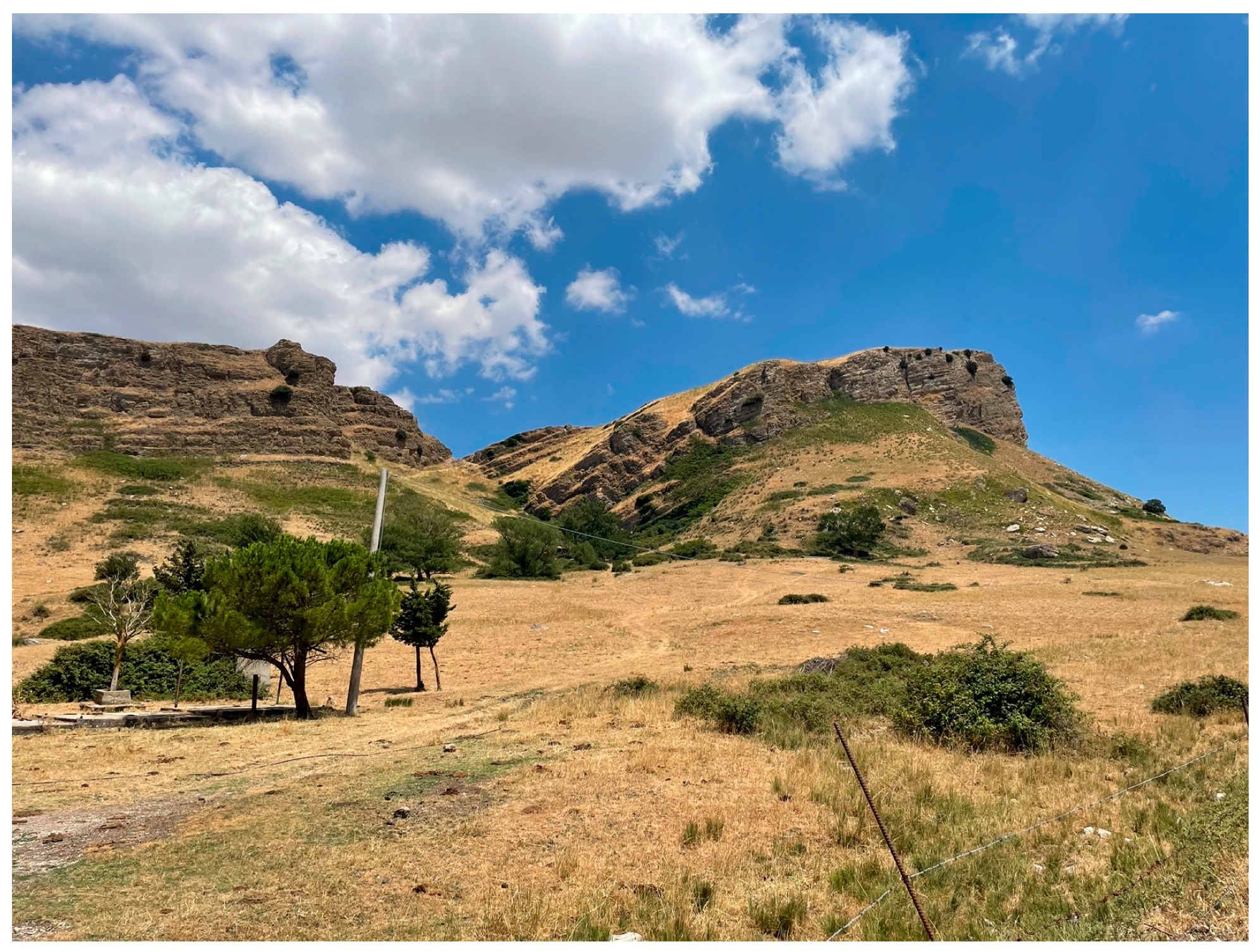
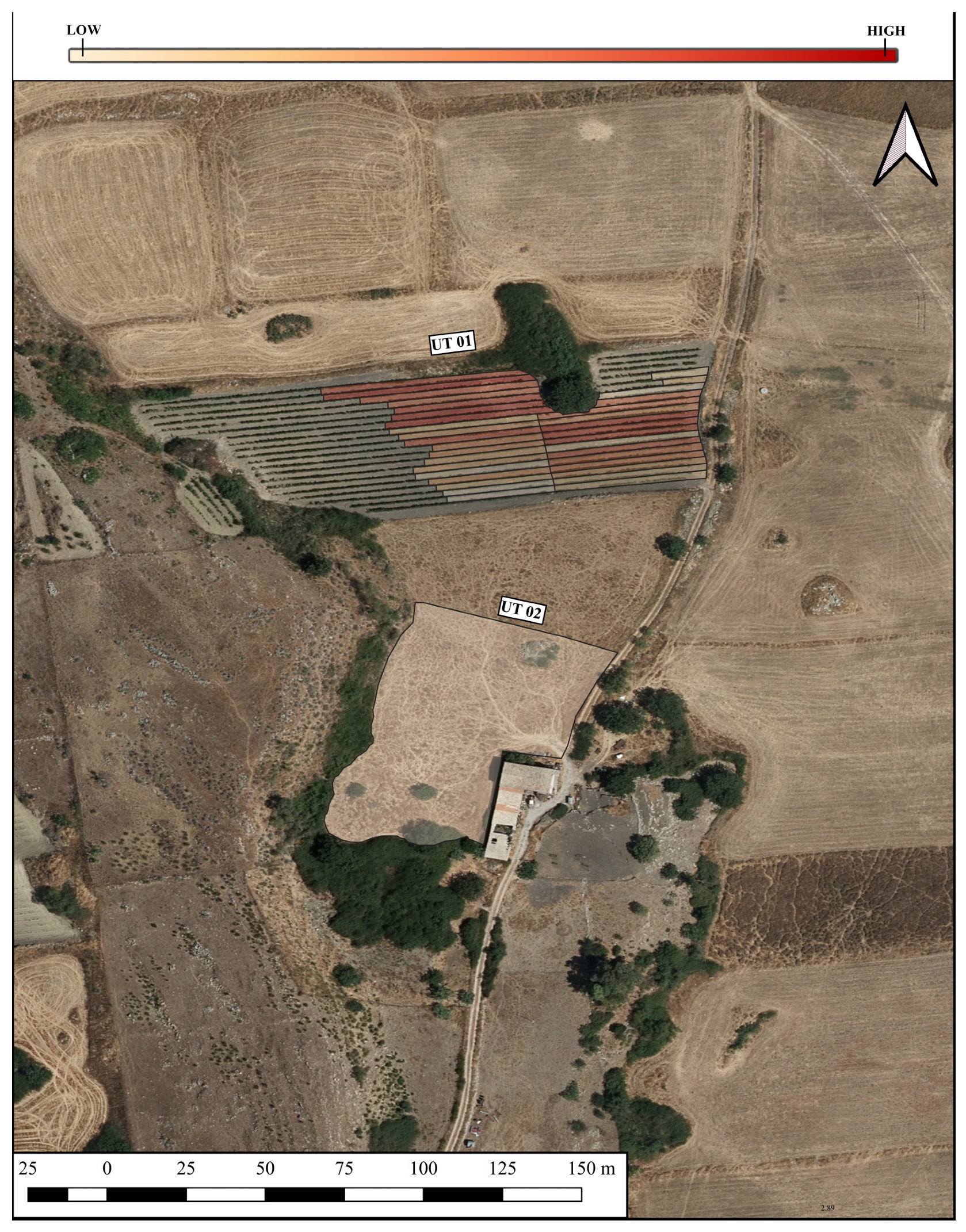
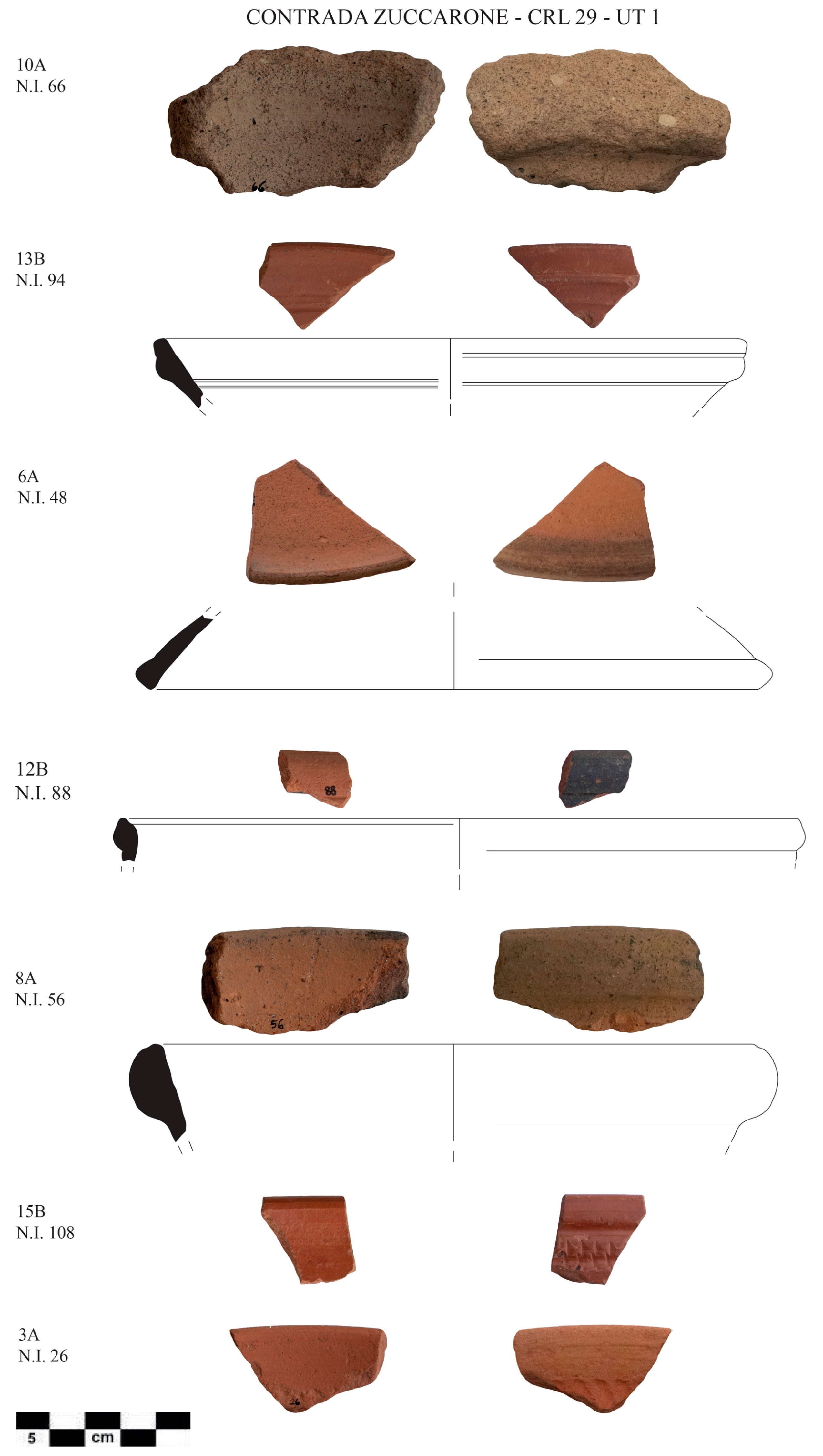
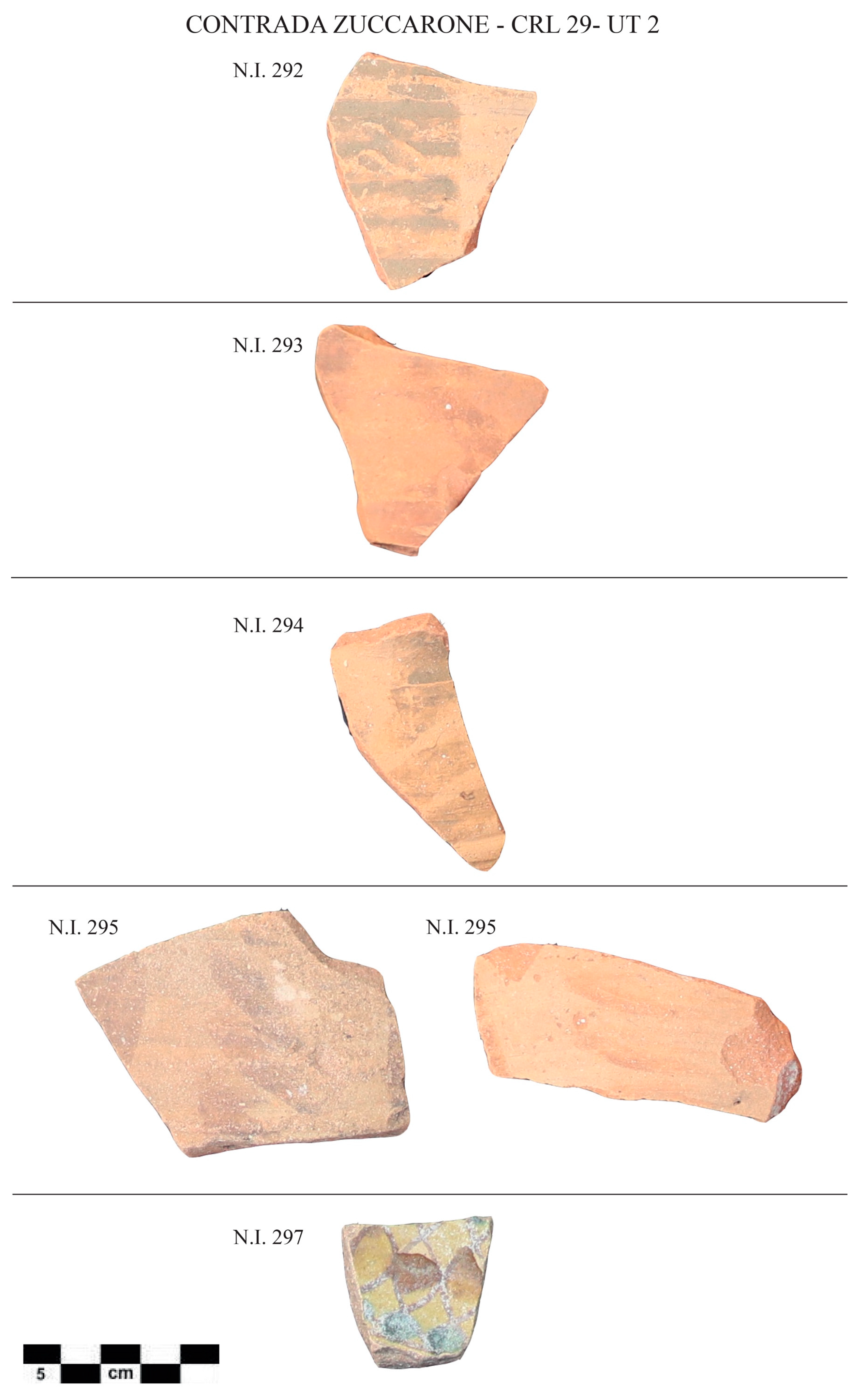
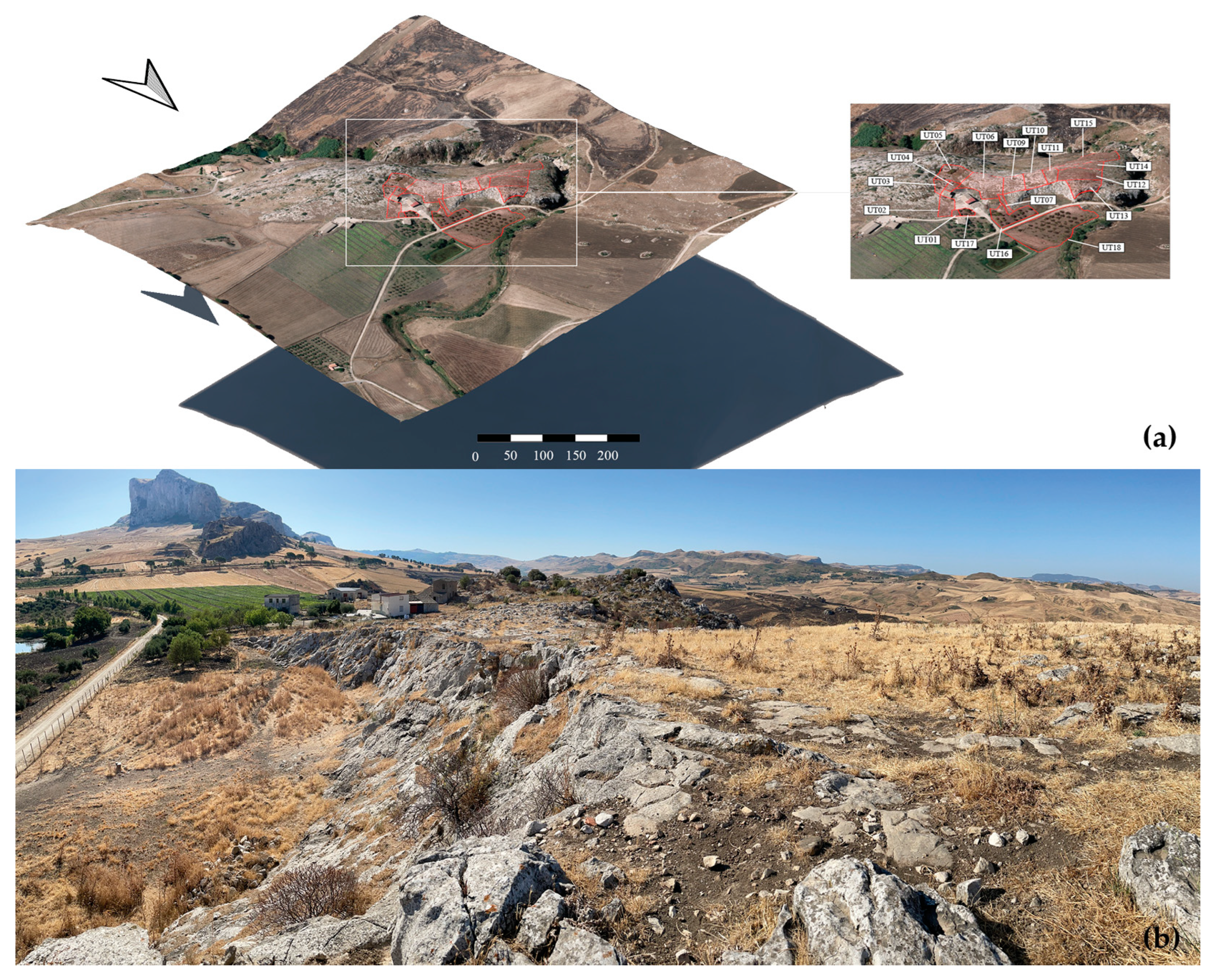

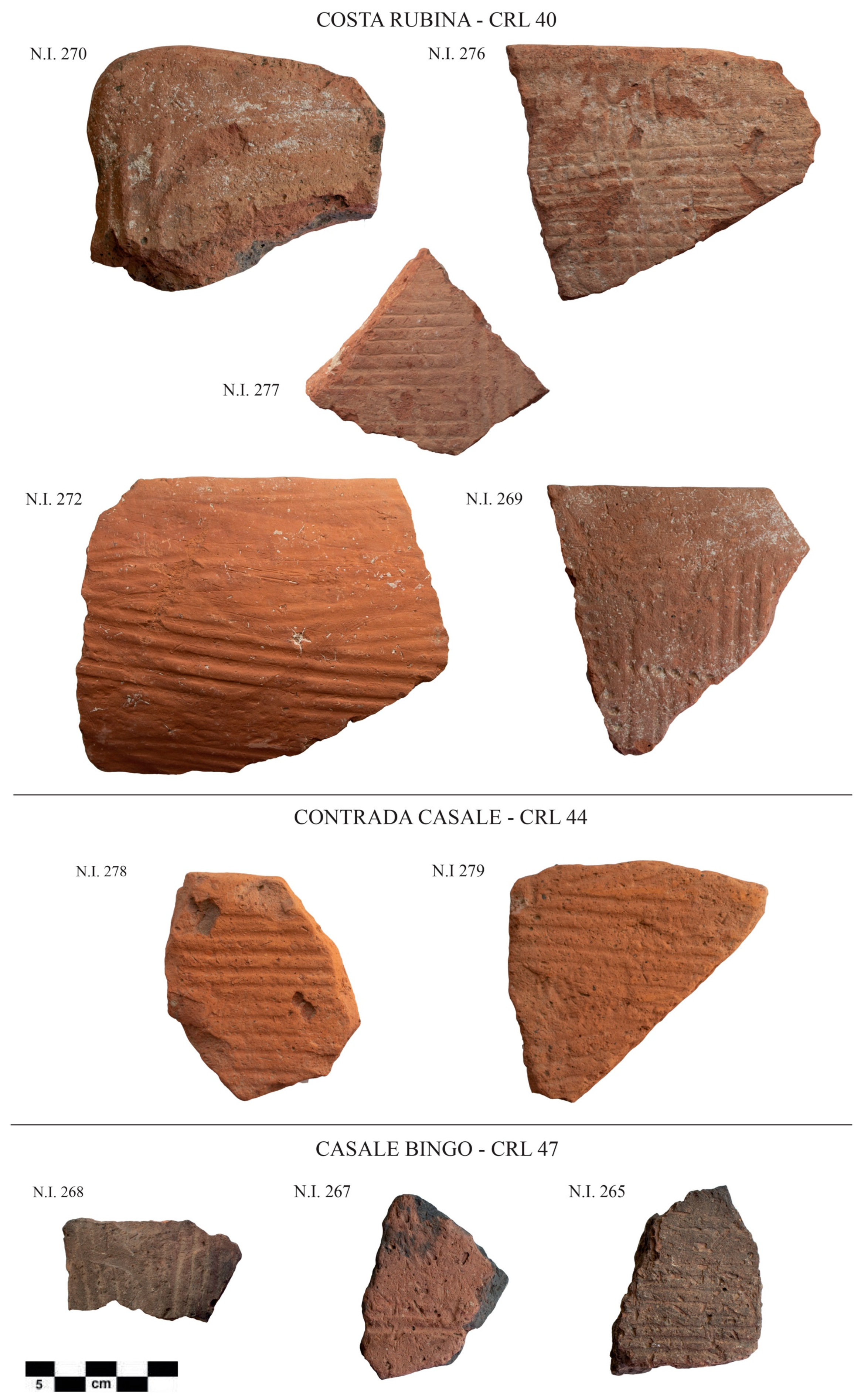

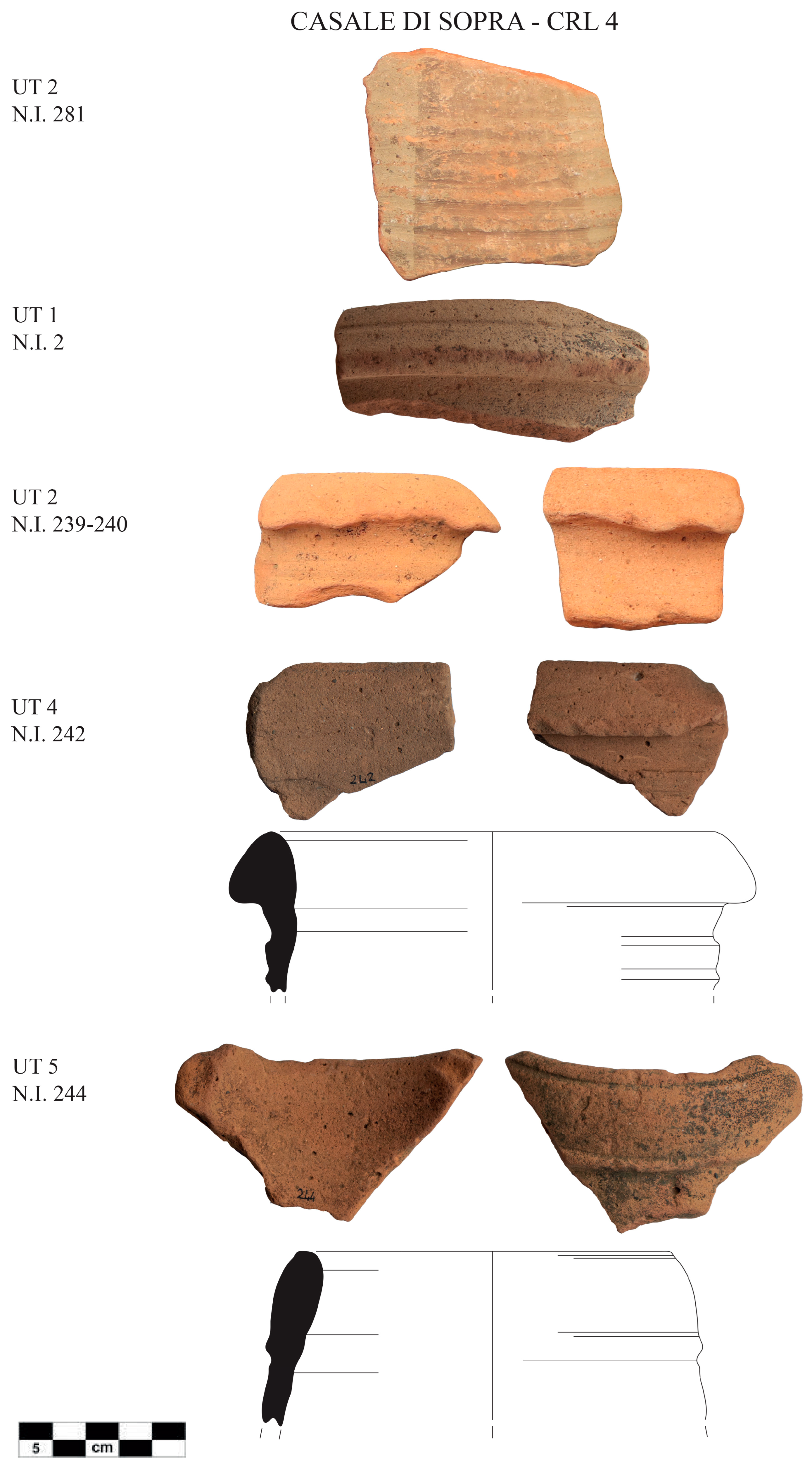
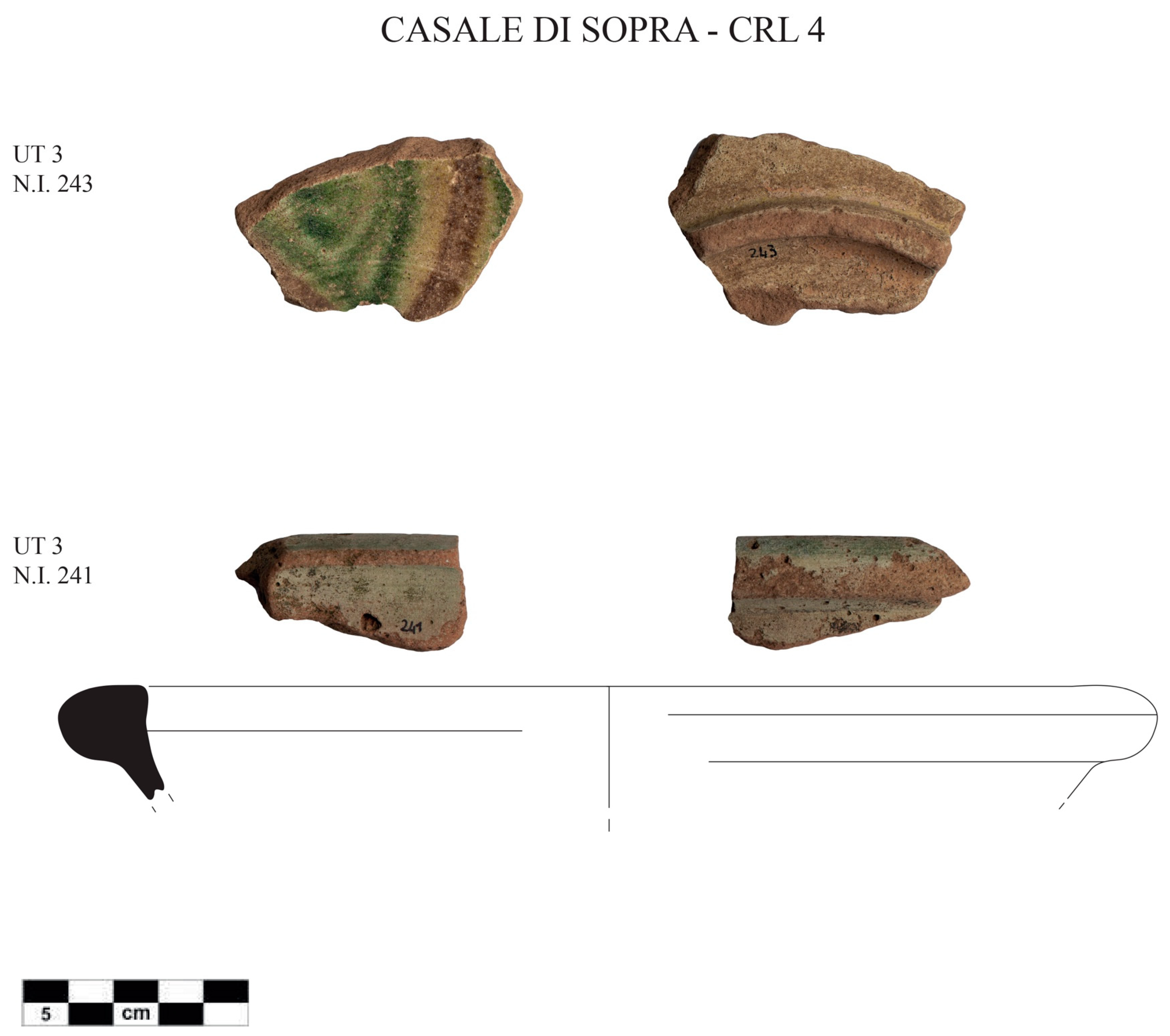
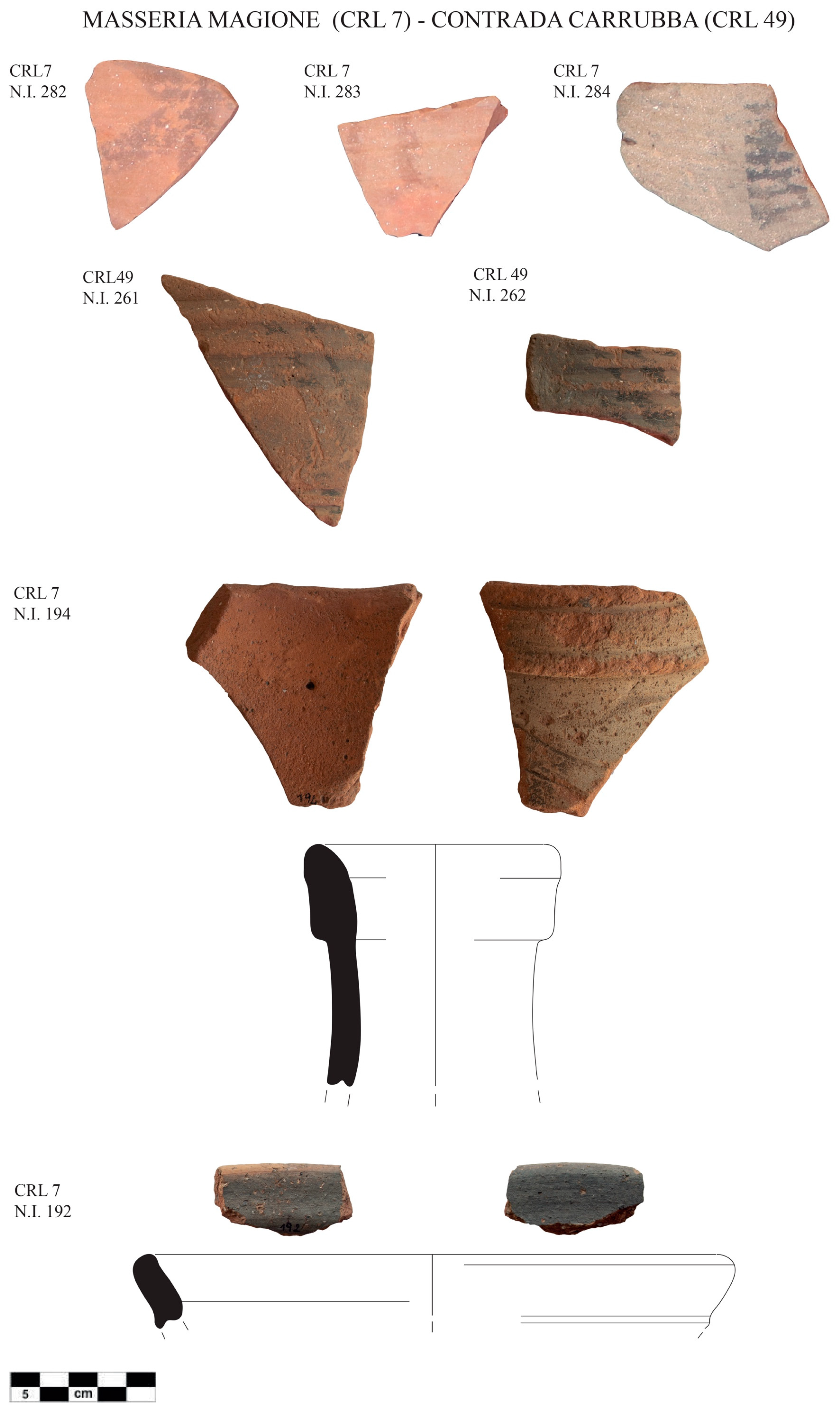
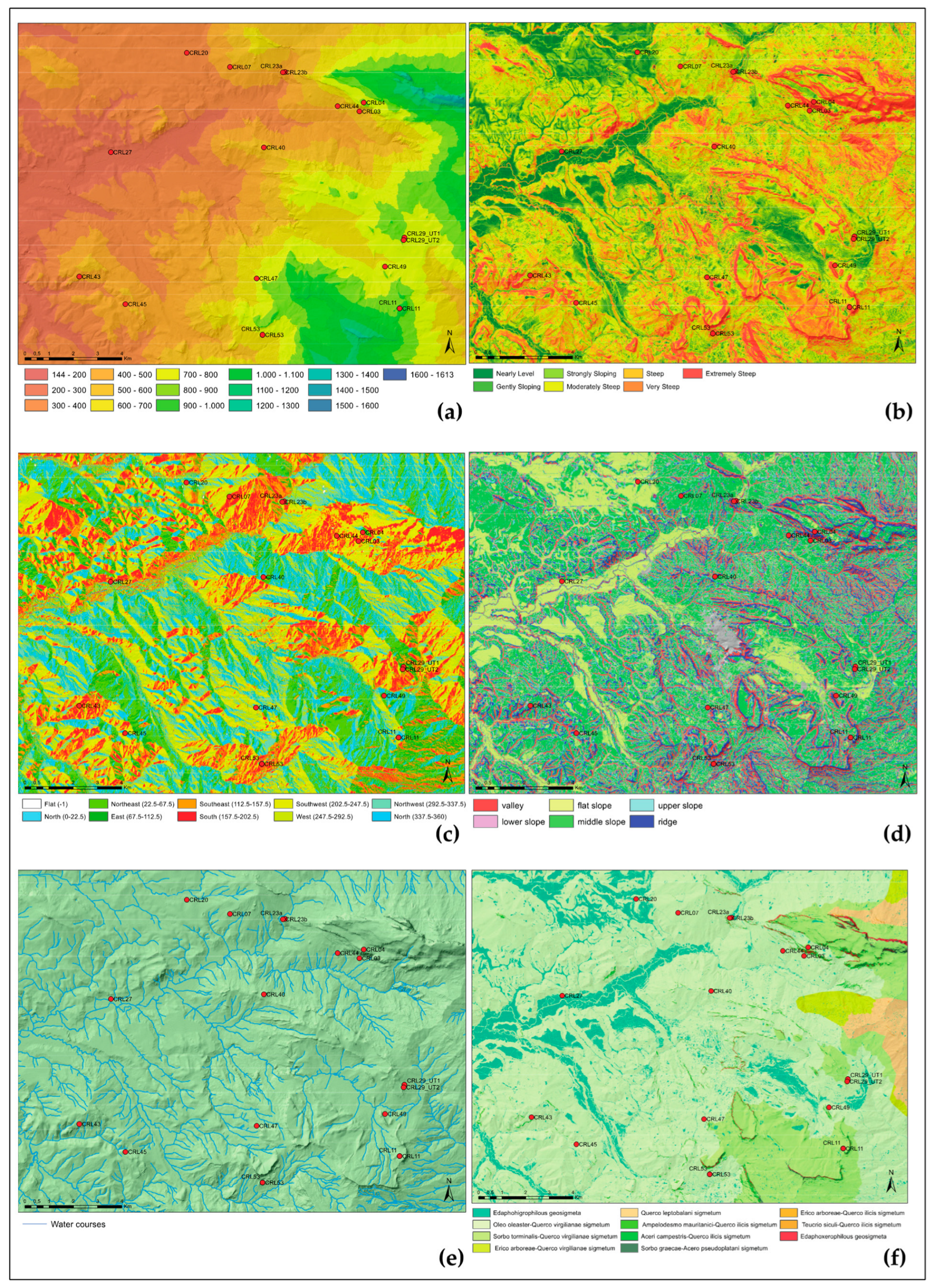
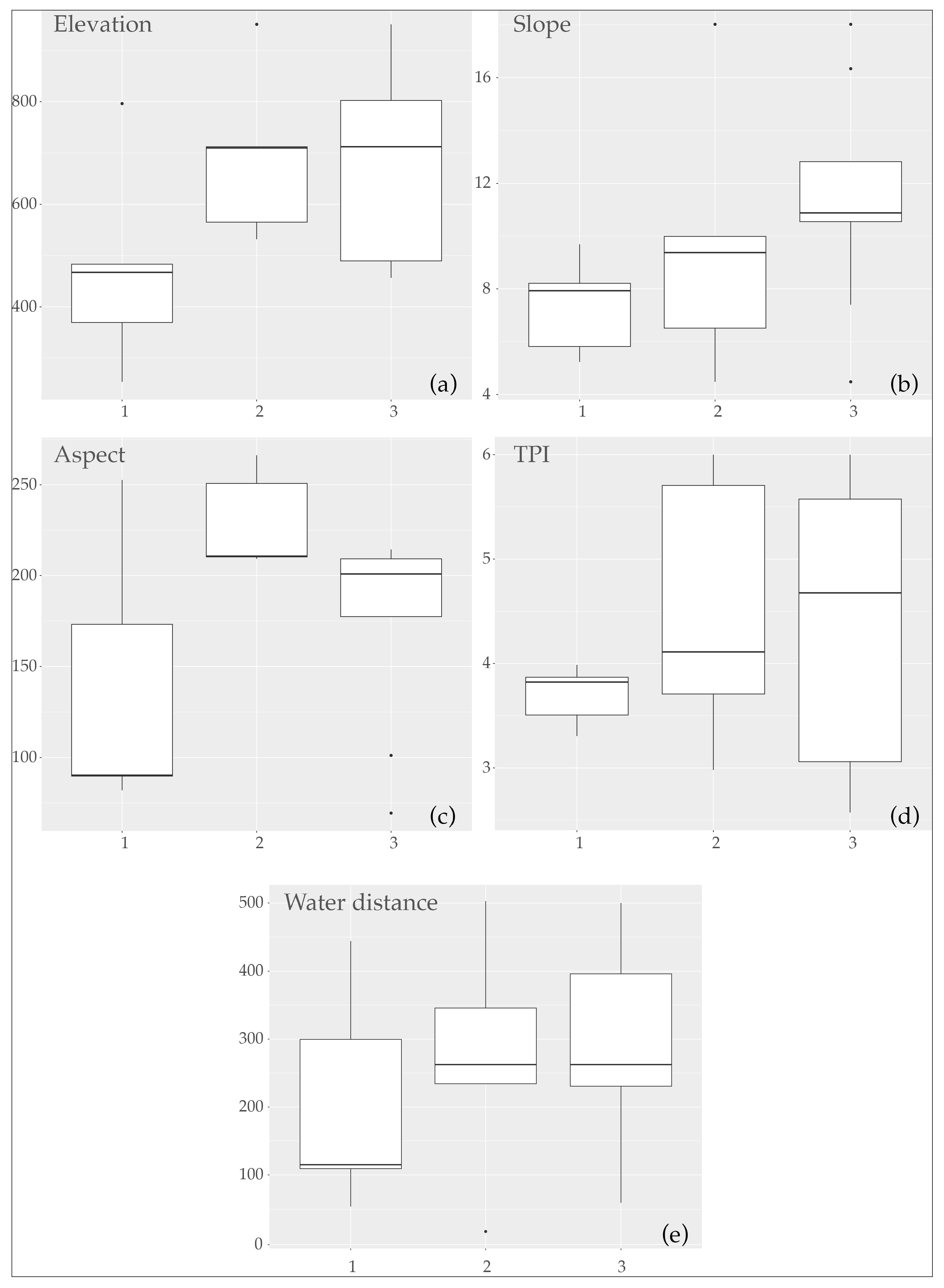

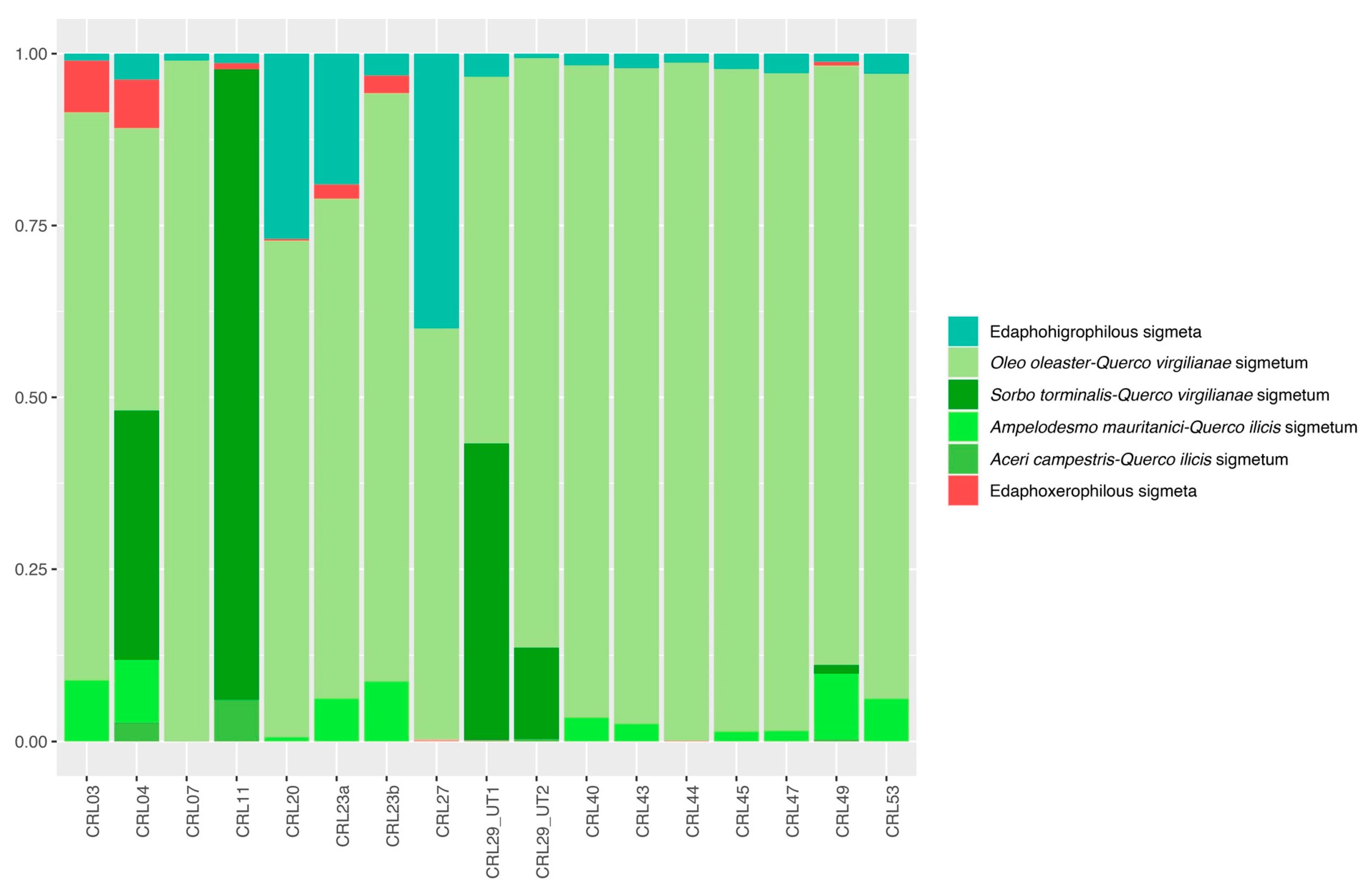
| ID | Site Names | Period * | Elevation [m] | Slope (°) | Aspect (°) | TPI | Water Dist. [m] |
|---|---|---|---|---|---|---|---|
| CRL03 | Casale di Sotto | 3 | 558 | 7.4 | 214.4 | 4 | 244 |
| CRL04 | Casale di Sopra | 3 | 824 | 16.3 | 207.4 | 6 | 472 |
| CRL07 | Masseria Magione | 3 | 476 | 10.6 | 185.7 | 3 | 396 |
| CRL11 | Cozzo Spolentino | 2, 3 | 952 | 18.1 | 210.7 | 6 | 346 |
| CRL20 | Masseria Patrìa | 1 | 367 | 8.2 | 252.5 | 3 | 300 |
| CRL23a | Case Scalilli/Gole del Drago | 1 | 483 | 5.8 | 90.2 | 4 | 115 |
| CRL23b | Case Scalilli/Gole del Drago | 3 | 489 | 10.8 | 200.8 | 5 | 111 |
| CRL27 | Strasatto/Case Scuderi | 1 | 254 | 5.2 | 173.1 | 3 | 54 |
| CRL29_UT1 | Zuccarone | 1 | 798 | 9.7 | 82.1 | 4 | 444 |
| CRL29_UT2 | Zuccarone | 3 | 804 | 10.8 | 101.2 | 3 | 500 |
| CRL40 | Costa Rubina | 2 | 565 | 9.3 | 210.3 | 4 | 503 |
| CRL43 | Case Grandi di Giammaria | 3 | 455 | 12.8 | 177.5 | 5 | 60 |
| CRL44 | Contrada Casale | 2 | 531 | 9,9 | 266.2 | 3 | 19 |
| CRL45 | Casa Paternostro | 1 | 465 | 7.9 | 99.7 | 4 | 109. |
| CRL47 | Case Bingo | 2 | 709 | 6.6 | 250.8 | 4 | 234 |
| CRL49 | Contrada Carrubba | 3 | 733 | 1.7 | 69.4 | 3 | 231 |
| CRL53 | Contrada Castro | 2, 3 | 712 | 4.5 | 209.2 | 6 | 262 |
Disclaimer/Publisher’s Note: The statements, opinions and data contained in all publications are solely those of the individual author(s) and contributor(s) and not of MDPI and/or the editor(s). MDPI and/or the editor(s) disclaim responsibility for any injury to people or property resulting from any ideas, methods, instructions or products referred to in the content. |
© 2024 by the authors. Licensee MDPI, Basel, Switzerland. This article is an open access article distributed under the terms and conditions of the Creative Commons Attribution (CC BY) license (https://creativecommons.org/licenses/by/4.0/).
Share and Cite
Castrorao Barba, A.; Aleo Nero, C.; Battaglia, G.; Zambito, L.; Virga, L.; Messina, A.; Cangemi, M.; Bazan, G. Continuity, Resilience, and Change in Rural Settlement Patterns from the Roman to Islamic Period in the Sicani Mountains (Central-Western Sicily). Land 2024, 13, 400. https://doi.org/10.3390/land13030400
Castrorao Barba A, Aleo Nero C, Battaglia G, Zambito L, Virga L, Messina A, Cangemi M, Bazan G. Continuity, Resilience, and Change in Rural Settlement Patterns from the Roman to Islamic Period in the Sicani Mountains (Central-Western Sicily). Land. 2024; 13(3):400. https://doi.org/10.3390/land13030400
Chicago/Turabian StyleCastrorao Barba, Angelo, Carla Aleo Nero, Giuseppina Battaglia, Luca Zambito, Ludovica Virga, Alessandra Messina, Marco Cangemi, and Giuseppe Bazan. 2024. "Continuity, Resilience, and Change in Rural Settlement Patterns from the Roman to Islamic Period in the Sicani Mountains (Central-Western Sicily)" Land 13, no. 3: 400. https://doi.org/10.3390/land13030400
APA StyleCastrorao Barba, A., Aleo Nero, C., Battaglia, G., Zambito, L., Virga, L., Messina, A., Cangemi, M., & Bazan, G. (2024). Continuity, Resilience, and Change in Rural Settlement Patterns from the Roman to Islamic Period in the Sicani Mountains (Central-Western Sicily). Land, 13(3), 400. https://doi.org/10.3390/land13030400






